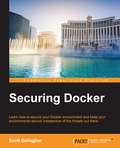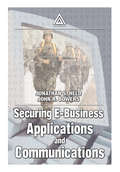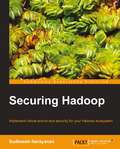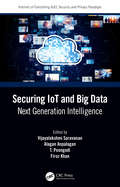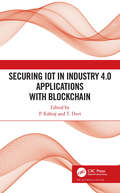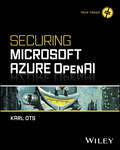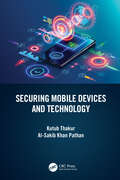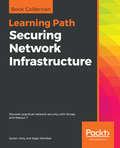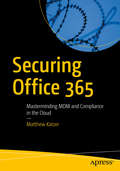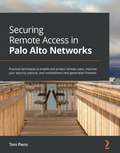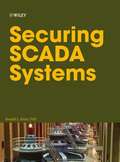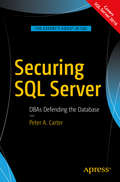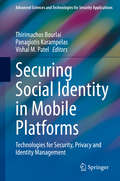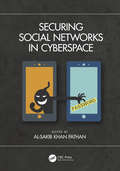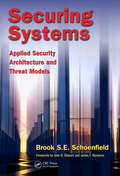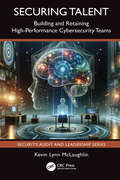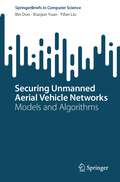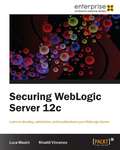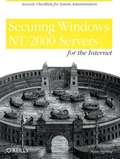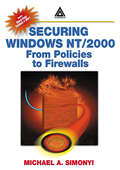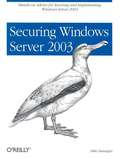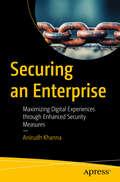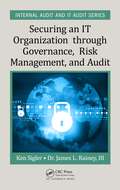- Table View
- List View
Securing Docker
by Scott GallagherLearn how to secure your Docker environment and keep your environments secure irrespective of the threats out there About This Book * Gain confidence in using Docker for containerization without compromising on security * This book covers different techniques to help you develop your container security skills * It is loaded with practical examples and real-world scenarios to secure your container-based applications Who This Book Is For This book is for developers who wish to use Docker as their testing platform as well as security professionals who are interested in securing Docker containers. You must be familiar with the basics of Docker. What You Will Learn * Find out how to secure your Docker hosts and nodes * Secure your Docker components * Explore different security measures/methods for Linux kernels * Install and run the Docker Bench security application * Monitor and report security issues * Familiarize yourself with third-party tools such as Traffic Authorization, Summon, sVirt, and SELinux to secure your Docker environment In Detail With the rising integration and adoption of Docker containers, there is a growing need to ensure their security. The purpose of this book is to provide techniques and enhance your skills to secure Docker containers easily and efficiently. The book starts by sharing the techniques to configure Docker components securely and explore the different security measures/methods one can use to secure the kernel. Furthermore, we will cover the best practices to report Docker security findings and will show you how you can safely report any security findings you come across. Toward the end, we list the internal and third-party tools that can help you immunize your Docker environment. By the end of this book, you will have a complete understanding of Docker security so you are able to protect your container-based applications. Style and approach This book is your one-stop solution to resolve all your Docker security concerns. It will familiarize you with techniques to safeguard your applications that run on Docker containers.
Securing E-Business Applications and Communications
by John Bowers Jonathan S. HeldThis book walks readers through the process of setting up a secure E-commerce Web site. It includes implementation examples for Unix (Solaris and Linux), Windows NT 4.0, and Windows 2000. The authors pay particular attention to the security issues involved. They also highlight the plethora of encryption algorithms that are instrumental in securing data. Together, the authors and the reader develop a site from concept to implementation. The material makes use of numerous coding examples to illustrate how to use the most current technologies - from Microsoft, Sun, and others - to support secure transactions.
Securing Hadoop
by Sudheesh NarayananThis book is a step-by-step tutorial filled with practical examples which will focus mainly on the key security tools and implementation techniques of Hadoop security.This book is great for Hadoop practitioners (solution architects, Hadoop administrators, developers, and Hadoop project managers) who are looking to get a good grounding in what Kerberos is all about and who wish to learn how to implement end-to-end Hadoop security within an enterprise setup. It's assumed that you will have some basic understanding of Hadoop as well as be familiar with some basic security concepts.
Securing IoT and Big Data: Next Generation Intelligence (Internet of Everything (IoE))
by Alagan Anpalagan T. Poongodi Vijayalakshmi Saravanan Firoz KhanThis book covers IoT and Big Data from a technical and business point of view. The book explains the design principles, algorithms, technical knowledge, and marketing for IoT systems. It emphasizes applications of big data and IoT. It includes scientific algorithms and key techniques for fusion of both areas. Real case applications from different industries are offering to facilitate ease of understanding the approach. The book goes on to address the significance of security algorithms in combing IoT and big data which is currently evolving in communication technologies. The book is written for researchers, professionals, and academicians from interdisciplinary and transdisciplinary areas. The readers will get an opportunity to know the conceptual ideas with step-by-step pragmatic examples which makes ease of understanding no matter the level of the reader.
Securing IoT in Industry 4.0 Applications with Blockchain
by P. KalirajThe Industry 4.0 revolution is changing the world around us. Artificial intelligence and machine learning, automation and robotics, big data, Internet of Things, augmented reality, virtual reality, and creativity are the tools of Industry 4.0. Improved collaboration is seen between smart systems and humans, which merges humans' critical and cognitive thinking abilities with highly accurate and fast industrial automation. Securing IoT in Industry 4.0 Applications with Blockchain examines the role of IoT in Industry 4.0 and how it can be made secure through various technologies including blockchain. The book begins with an in-depth look at IoT and discusses applications, architecture, technologies, tools, and programming languages. It then examines blockchain and cybersecurity, as well as how blockchain achieves cybersecurity. It also looks at cybercrimes and their preventive measures and issues related to IoT security and trust. Features An overview of how IoT is used to improve the performance of Industry 4.0 systems The evolution of the Industrial Internet of Things (IIoT), its proliferation and market share, and some examples across major industries An exploration of how smart farming is helping farmers prevent plant disease The concepts behind the Internet of Nano Things (IoNT), including the nanomachine and nanonetwork architecture and nano-communication paradigms A look at how blockchains can enhance cybersecurity in a variety of applications, including smart contracts, transferring financial instruments, and Public Key Infrastructure An overview of the structure and working of a blockchain, including the types, evolution, benefits, and applications of blockchain to industries A framework of technologies designed to shield networks, computers, and data from malware, vulnerabilities, and unauthorized activities An explanation of the automation system employed in industries along with its classification, functionality, flexibility, limitations, and applications
Securing Microsoft Azure OpenAI (Tech Today)
by Karl OtsSecurely harness the full potential of OpenAI’s artificial intelligence tools in Azure Securing Microsoft Azure OpenAI is an accessible guide to leveraging the comprehensive AI capabilities of Microsoft Azure while ensuring the utmost data security. This book introduces you to the collaborative powerhouse of Microsoft Azure and OpenAI, providing easy access to cutting-edge language models like GPT-4o, GPT-3.5-Turbo, and DALL-E. Designed for seamless integration, the Azure OpenAI Service revolutionizes applications from dynamic content generation to sophisticated natural language translation, all hosted securely within Microsoft Azure’s environment. Securing Microsoft Azure OpenAI demonstrates responsible AI deployment, with a focus on identifying potential harm and implementing effective mitigation strategies. The book provides guidance on navigating risks and establishing best practices for securely and responsibly building applications using Azure OpenAI. By the end of this book, you’ll be equipped with the best practices for securely and responsibly harnessing the power of Azure OpenAI, making intelligent decisions that respect user privacy and maintain data integrity.
Securing Mobile Devices and Technology
by Al-Sakib Khan Pathan Kutub ThakurThis book describes the detailed concepts of mobile security. The first two chapters provide a deeper perspective on communication networks, while the rest of the book focuses on different aspects of mobile security, wireless networks, and cellular networks. This book also explores issues of mobiles, IoT (Internet of Things) devices for shopping and password management, and threats related to these devices. A few chapters are fully dedicated to the cellular technology wireless network. The management of password for the mobile with the modern technologies that helps on how to create and manage passwords more effectively is also described in full detail. This book also covers aspects of wireless networks and their security mechanisms. The details of the routers and the most commonly used Wi-Fi routers are provided with some step-by-step procedures to configure and secure them more efficiently. This book will offer great benefits to the students of graduate and undergraduate classes, researchers, and also practitioners.
Securing Network Infrastructure: Discover practical network security with Nmap and Nessus 7
by Sagar Rahalkar Sairam JettyPlug the gaps in your network's infrastructure with resilient network security models Key Features Develop a cost-effective and end-to-end vulnerability management program Explore best practices for vulnerability scanning and risk assessment Understand and implement network enumeration with Nessus and Network Mapper (Nmap) Book Description Digitization drives technology today, which is why it's so important for organizations to design security mechanisms for their network infrastructures. Analyzing vulnerabilities is one of the best ways to secure your network infrastructure. This Learning Path begins by introducing you to the various concepts of network security assessment, workflows, and architectures. You will learn to employ open source tools to perform both active and passive network scanning and use these results to analyze and design a threat model for network security. With a firm understanding of the basics, you will then explore how to use Nessus and Nmap to scan your network for vulnerabilities and open ports and gain back door entry into a network. As you progress through the chapters, you will gain insights into how to carry out various key scanning tasks, including firewall detection, OS detection, and access management to detect vulnerabilities in your network. By the end of this Learning Path, you will be familiar with the tools you need for network scanning and techniques for vulnerability scanning and network protection. This Learning Path includes content from the following Packt books: Network Scanning Cookbook by Sairam Jetty Network Vulnerability Assessment by Sagar Rahalkar What you will learn Explore various standards and frameworks for vulnerability assessments and penetration testing Gain insight into vulnerability scoring and reporting Discover the importance of patching and security hardening Develop metrics to measure the success of a vulnerability management program Perform configuration audits for various platforms using Nessus Write custom Nessus and Nmap scripts on your own Install and configure Nmap and Nessus in your network infrastructure Perform host discovery to identify network devices Who this book is for This Learning Path is designed for security analysts, threat analysts, and security professionals responsible for developing a network threat model for an organization. Professionals who want to be part of a vulnerability management team and implement an end-to-end robust vulnerability management program will also find this Learning Path useful.
Securing Office 365: Masterminding MDM and Compliance in the Cloud
by Matthew KatzerUnderstand common security pitfalls and discover weak points in your organization’s data security, and what you can do to combat them. This book includes the best approaches to managing mobile devices both on your local network and outside the office.Data breaches, compliance fines, and distribution of personally identifiable information (PII) without encryption or safeguards place businesses of all types at risk. In today’s electronic world, you must have a secure digital footprint that is based on business processes that are designed to protect information. This book is written for business owners, chief information security officers (CISO), and IT managers who want to securely configure Office 365. You will follow the Microsoft cybersecurity road map through a progressive tutorial on how to configure the security services in Office 365 to protect and manage your business.What You’ll LearnManage security with the Azure Security Center and the Office 365 Compliance CenterConfigure information protection for document and electronic communicationsMonitor security for your business in the cloudUnderstand Mobile Application Management (MAM) and Mobile Device Management (MDM)Prevent data loss in Office 365Configure and manage the compliance manager tools for NIST and GDPRWho This Book Is ForIT managers and compliance and cybersecurity officers who have responsibility for compliance and data security in their business
Securing Remote Access in Palo Alto Networks: Practical techniques to enable and protect remote users, improve your security posture, and troubleshoot next-generation firewalls
by Tom PiensExplore everything you need to know to set up secure remote access, harden your firewall deployment, and protect against phishingKey FeaturesLearn the ins and outs of advanced Palo Alto features and troubleshoot any situation with easeBecome well-versed with setting up your own lab for continued developmentGain an in-depth understanding of some of the topics that are covered less commonly in the PCNSE examBook DescriptionThis book builds on the content found in Mastering Palo Alto Networks, providing you with the information you need to know to fully understand, deploy, and troubleshoot Palo Alto Networks Strata products. Complete with step-by-step explanations of essential concepts, practical examples, and step-by-step instructions, you will gain a solid understanding of how to configure and deploy Palo Alto Networks remote access products. As you advance, you will learn how to design, deploy, and troubleshoot physical and virtual products. Later, you will explore new features and discover how to incorporate them into your environment. By the end of this Palo Alto Networks book, you will have mastered troubleshooting methodologies and have the confidence you need to be able to deploy phishing protection.What you will learnUnderstand how log forwarding is configured on the firewallFocus on effectively enabling remote accessExplore alternative ways for connecting users and remote networksProtect against phishing with credential detectionUnderstand how to troubleshoot complex issues confidentlyStrengthen the security posture of your firewallsWho this book is forThis book is for anyone who wants to learn more about remote access for users and remote locations by using GlobalProtect and Prisma access and by deploying Large Scale VPN. Basic knowledge of Palo Alto Networks, network protocols, and network design will be helpful, which is why reading Mastering Palo Alto Networks is recommended first to help you make the most of this book.
Securing SCADA Systems
by Ronald L. KrutzBestselling author Ron Krutz once again demonstrates his ability to make difficult security topics approachable with this first in-depth look at SCADA (Supervisory Control And Data Acquisition) systems Krutz discusses the harsh reality that natural gas pipelines, nuclear plants, water systems, oil refineries, and other industrial facilities are vulnerable to a terrorist or disgruntled employee causing lethal accidents and millions of dollars of damage-and what can be done to prevent this from happening Examines SCADA system threats and vulnerabilities, the emergence of protocol standards, and how security controls can be applied to ensure the safety and security of our national infrastructure assets
Securing SQL Server
by Peter A. CarterProtect your data from attack by using SQL Server technologies to implement a defense-in-depth strategy, performing threat analysis, and encrypting sensitive data as a last line of defense against compromise. The multi-layered approach in this book helps ensure that a single breach doesn't lead to loss or compromise of your data that is confidential and important to the business. Database professionals in today's world deal increasingly often with repeated data attacks against high-profile organizations and sensitive data. It is more important than ever to keep your company's data secure. Securing SQL Server demonstrates how administrators and developers can both play their part in the protection of a SQL Server environment. This book provides a comprehensive technical guide to the security model, and to encryption within SQL Server, including coverage of the latest security technologies such as Always Encrypted, Dynamic Data Masking, and Row Level Security. Most importantly, the book gives practical advice and engaging examples on how to defend your data -- and ultimately your job! -- against attack and compromise. Covers the latest security technologies, including Always Encrypted, Dynamic Data Masking, and Row Level Security Promotes security best-practice and strategies for defense-in-depth of business-critical database assets Gives advice on performing threat analysis and reducing the attack surface that your database presents to the outside world What You Will Learn Perform threat analysis Implement access level control and data encryption Avoid non-reputability by implementing comprehensive auditing Use security metadata to ensure your security policies are enforced Apply the latest SQL Server technologies to increase data security Mitigate the risk of credentials being stolen Who This Book Is For SQL Server database administrators who need to understand and counteract the threat of attacks against their company's data. The book is also of interest to database administrators of other platforms, as several of the attack techniques are easily generalized beyond SQL Server and to other database brands.
Securing SQL Server: DBAs Defending the Database
by Peter A. CarterProtect your data from attack by using SQL Server technologies to implement a defense-in-depth strategy for your database enterprise. This new edition covers threat analysis, common attacks and countermeasures, and provides an introduction to compliance that is useful for meeting regulatory requirements such as the GDPR. The multi-layered approach in this book helps ensure that a single breach does not lead to loss or compromise of confidential, or business sensitive data.Database professionals in today’s world deal increasingly with repeated data attacks against high-profile organizations and sensitive data. It is more important than ever to keep your company’s data secure. Securing SQL Server demonstrates how developers, administrators and architects can all play their part in the protection of their company’s SQL Server enterprise.This book not only provides a comprehensive guide to implementing the security model in SQL Server, including coverage of technologies such as Always Encrypted, Dynamic Data Masking, and Row Level Security, but also looks at common forms of attack against databases, such as SQL Injection and backup theft, with clear, concise examples of how to implement countermeasures against these specific scenarios. Most importantly, this book gives practical advice and engaging examples of how to defend your data, and ultimately your job, against attack and compromise.What You'll LearnPerform threat analysisImplement access level control and data encryptionAvoid non-reputability by implementing comprehensive auditingUse security metadata to ensure your security policies are enforcedMitigate the risk of credentials being stolenPut countermeasures in place against common forms of attackWho This Book Is ForDatabase administrators who need to understand and counteract the threat of attacks against their company’s data, and useful for SQL developers and architects
Securing Social Identity in Mobile Platforms: Technologies for Security, Privacy and Identity Management (Advanced Sciences and Technologies for Security Applications)
by Vishal M. Patel Panagiotis Karampelas Thirimachos BourlaiThe book presents novel research in the areas of social identity and security when using mobile platforms. The topics cover a broad range of applications related to securing social identity as well as the latest advances in the field, including the presentation of novel research methods that are in the service of all citizens using mobile devices. More specifically, academic, industry-related and government (law enforcement, intelligence and defence) organizations, will benefit from the research topics of this book that cover the concept of identity management and security using mobile platforms from various perspectives, i.e. whether a user navigates to social media, accesses their own phone devices, access their bank accounts, uses online shopping service providers, accesses their personal documents or accounts with valuable information, surfs the internet, or even becomes a victim of cyberattacks. In all of the aforementioned cases, there is a need for mobile related technologies that protect the users’ social identity and well-being in the digital world, including the use of biometrics, cybersecurity software and tools, active authentication and identity anti-spoofing algorithms and more.
Securing Social Networks in Cyberspace
by Al-Sakib Khan PathanThis book collates the key security and privacy concerns faced by individuals and organizations who use various social networking sites. This includes activities such as connecting with friends, colleagues, and family; sharing and posting information; managing audio, video, and photos; and all other aspects of using social media sites both professionally and personally. In the setting of the Internet of Things (IoT) that can connect millions of devices at any one time, the security of such actions is paramount. Securing Social Networks in Cyberspace discusses user privacy and trust, location privacy, protecting children, managing multimedia content, cyberbullying, and much more. Current state-of-the-art defense mechanisms that can bring long-term solutions to tackling these threats are considered in the book. This book can be used as a reference for an easy understanding of complex cybersecurity issues in social networking platforms and services. It is beneficial for academicians and graduate-level researchers. General readers may find it beneficial in protecting their social-media-related profiles.
Securing Systems: Applied Security Architecture and Threat Models
by Brook S. E. SchoenfieldInternet attack on computer systems is pervasive. It can take from less than a minute to as much as eight hours for an unprotected machine connected to the Internet to be completely compromised. It is the information security architect’s job to prevent attacks by securing computer systems. This book describes both the process and the practice of assessing a computer system’s existing information security posture. Detailing the time-tested practices of experienced security architects, it explains how to deliver the right security at the right time in the implementation lifecycle.
Securing Systems: Applied Security Architecture and Threat Models
by Brook S. SchoenfieldInternet attack on computer systems is pervasive. It can take from less than a minute to as much as eight hours for an unprotected machine connected to the Internet to be completely compromised. It is the information security architect's job to prevent attacks by securing computer systems. This book describes both the process and the practice of as
Securing Talent: Building and Retaining High-Performance Cybersecurity Teams (Security, Audit and Leadership Series)
by Kevin Lynn McLaughlinSecuring Talent: Building and Retaining High-Performance Cybersecurity Teams by Dr. Kevin Lynn McLaughlin offers a comprehensive and insightful exploration into the critical role culture plays in the cybersecurity field.Dr. McLaughlin, drawing from his extensive experience in cybersecurity leadership and risk management, addresses the acute shortage of cybersecurity professionals and underscores the importance of a supportive work environment in attracting and retaining top talent. The book begins with a personal anecdote illustrating the significant impact of organizational culture on employee engagement and leadership development. It then delves into the global scarcity of cybersecurity professionals, intensified by the increasing complexity of cyber threats and rapid technological advancements. This shortage poses a considerable risk to organizations across industries, making them vulnerable to data breaches, reputational damage, and significant economic losses. Dr. McLaughlin emphasizes the necessity of creating a positive and rewarding workplace environment to not only attract but also retain skilled professionals.The book discusses various factors contributing to the lack of qualified individuals in the field, such as inadequate investment in cybersecurity education and limited opportunities for skill development. Dr. McLaughlin argues that the high-stress nature of cybersecurity work, demanding long hours and intense focus, can deter potential talent. He advocates for investment in training programs, cultivation of the next generation of cybersecurity experts, and the creation of a workplace culture conducive to professional growth and satisfaction.
Securing Unmanned Aerial Vehicle Networks: Models and Algorithms (SpringerBriefs in Computer Science)
by Xiaojun Yuan Bin Duo Yifan LiuThis book focuses on the model and algorithm aspects of securing Unmanned Aerial Vehicle Networks (UAV). To equip readers with the essential knowledge required for conducting research in this field, it covers the foundational concepts of this topic as well. This book also offers a detailed insight into UAV networks from the physical layer security point of view.The authors discuss the appropriate channel models for characterizing various propagation environments that UAV networks are exposed. The state-of-the-art technologies, such as UAV trajectory design, cooperative jamming and reconfigurable intelligent surfaces are covered. The corresponding algorithms for significantly improving the security of UAV networks, along with practical case studies on topics such as energy-efficient and secure UAV networks, elevation angle-distance trade-off for securing UAV networks and securing UAV networks with the aid of reconfigurable intelligent surfaces are presented as well. Last, this book outlines the future challenges and research directions to facilitate further studies on secure UAV networks. This book is suitable reading for graduate students and researchers who are interested in the research areas of UAV networking and communications, IoT security, and physical layer security in wireless networks. Professionals working within these related fields will also benefit from this book.
Securing WebLogic Server 12c
by Rinaldi Vincenzo Luca MasiniThis book is written in simple, easy to understand format with lots of screenshots and step-by-step explanations. If you are a WebLogic Server administrator looking forward to a step by step guide to administer and configure WebLogic security, then this is the guide for you. Working knowledge of WebLogic is required.
Securing Windows NT/2000 Servers for the Internet
by Stefan NorbergIn recent years, Windows NT and 2000 systems have emerged as viable platforms for Internet servers, but securing Windows for Internet use is a complex task. This concise guide simplifies the task by paring down installation and configuration instructions into a series of security checklists for security administration, including hardening servers for use as "bastion hosts," performing secure remote administration with OpenSSH, TCP Wrappers, VNC, and the new Windows 2000 Terminal Services.
Securing Windows NT/2000: From Policies to Firewalls
by Michael A. SimonyiIn today's business environment it is no longer safe to conduct any business on the Internet without first protecting it. Small, medium, and large corporations require a massive dose of security to protect themselves and their digital assets from unwanted intruders. A managerial guide and practical technical tutorial, Securing Windows NT/2000: From
Securing Windows Server 2003
by Mike DanseglioIf you use Windows 2003 Server at a small to medium-sized organization, or use Microsoft's Small Business Server, this thorough yet concise tutorial offers the hands-on advice you need for securing your network. Securing Windows Server 2003 not only shows you how to put Windows security tools to work, but guides you through ways to plan and implement a secure operating environment.
Securing an Enterprise: Maximizing Digital Experiences through Enhanced Security Measures
by Anirudh KhannaDive into the world of digital security and navigate its intricate landscape. In an era where digital reliance is ubiquitous, the need for robust cybersecurity measures has never been more pressing. Part of author Saurav Bhattacharya’s trilogy that covers the essential pillars of digital ecosystems—security, reliability, and usability—this book sheds light on the dynamic challenges posed by cyber threats, advocating for innovative security solutions that safeguard users while upholding their digital freedoms. Against the backdrop of rapid technological advancement and escalating cyber threats, this book addresses pressing security concerns at the forefront of our digital era. You’ll learn that trust plays a pivotal role in fostering a secure digital environment, enabling individuals and organizations to flourish without fear of malicious exploits. With transformative technologies like AI, blockchain, and quantum computing on the horizon, understanding and addressing cybersecurity fundamentals is essential for traversing the evolving digital landscape. Securing an Enterprise is your roadmap towards a future where technology aligns with humanity, fostering a more equitable, secure, and interconnected world. What You will Learn Explore advanced methodologies and innovative approaches to bolster cybersecurity Understand the potential impacts of the advancements on security Provide strategic guidance on adapting to security changes to ensure sustainability Take a holistic approach in reviewing security Who This Book Is For Cybersecurity Professionals, Technology Developers and Engineers
Securing an IT Organization through Governance, Risk Management, and Audit (ISSN)
by Ken E. Sigler James L. Rainey IIIThis book introduces two internationally recognized bodies of knowledge: COBIT 5 from a cybersecurity perspective and the NIST Framework for Improving Critical Infrastructure Cybersecurity (CSF). Emphasizing the processes directly related to governance, risk management, and audit, the book maps the CSF steps and activities to the methods defined in COBIT 5, extending the CSF objectives with practical and measurable activities that leverage operational risk understanding in a business context. This allows the ICT organization to convert high-level enterprise goals into manageable, specific goals rather than unintegrated checklist models.
